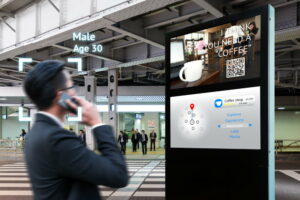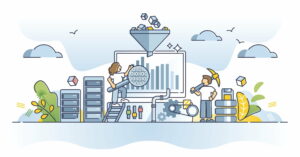
There are many ways businesses are using big data to make better decisions and operate more efficiently Organizations can use big data to optimize expenses and reduce costs. A modern data infrastructure can help get more value from data by accelerating decision making, simplifying operations, and powering analytics.
One of the many ways big data is helping companies operate more cost-effectively is through the construction of smart buildings. Companies around the world are projected to spend $304.3 billion on smart buildings by 2032.
Why Data-Driven Businesses Are Investing in Smart Buildings
You should see integrating technology into your commercial buildings as a good investment; the benefits and returns you get by optimizing workspaces and using the data you get from the smart devices are going to give you a good return on investment. We are going to look at how companies can use smart buildings and the Internet of Things (IoT) technologies to save money, find new streams of revenue, and boost their profile through green initiatives.
Minimizing energy costs
Location is the most important thing when it comes to CRE. The business is going to require a site for employees, customers, and suppliers. Needing the right location can mean that you are currently operating from a building that hasn’t been designed keeping modern energy efficiency in mind. Big data models make it easier to find the right location and make other important decisions.
When you have an occupancy system, you can easily know the zones that are being occupied and how they are used. The data is collected by the system and it then communicates with the building systems that are going to regulate facilities in that given area. This ensures that there isn’t energy being wasted.
When you collect data on how occupants in the building interact with machines, facilities, and spaces, you can easily address issues in a short time by coming up with more cost-effective alternatives. This means you can benefit from the location and save money by revising your lighting and energy usage and you are also taking advantage of the data you are collecting to improve functionality.
Increasing employee productivity
As we stated before, one of the biggest benefits of big data for most companies is that it boosts productivity. This is one of the most appealing benefits of smart buildings.
Lack of productivity is one of the most significant expenses for most employers, and it can easily end up affecting other areas of the business and can end up being a big issue when it comes to public relations. Many organizations don’t know the potential of their employees who are stifled because of the stress-inducing environments they are working in.
Making simple adjustments like temperatures, the layout of the office space, and lighting can have a positive impact on how the employees are feeling and performing. When you study their movement patterns when they are inside the building, you can come up with a plan for streamlining interaction and communication between visitors and employees, and also controlling the internal environment to make sure it suits the needs of those inside.
You are going to see productivity improve when people are inside comfortable spaces that have been equipped for functionality and working with their colleagues.
Improve staff well-being and reduce costs of absenteeism
Being in a happy environment is going to reduce stress, which is known to contribute to many conditions and illnesses. Having an efficient and eco-friendly workplace is going to make sure that your staff is working in great conditions. They will feel better and have a good mindset toward what they are working in.
Employers need to provide their employees with a safe and healthy environment. They can do this by making sure the workstation complies with DSE regulations and preventing hazards.
Discovering new sources of revenue
Many companies out there are investing a lot in commercial sites and they are not getting the full potential. This can be a result of business activities concentrating around a given hub inside the premise or some spaces being seen as uncomfortable or unsuitable by employees.
A good occupancy system is going to show you how frequently an area is used. With this knowledge, the area can be redesigned for greater utility or even create a new source of income for the organization by renting the facilities out. Some good examples of this are storage, shop floor space, or hot desk office facilities.
Having information on how shoppers or occupants are moving with the building will also help you make agreements with suppliers that want to benefit from product placement. You can easily provide them with real-time data on the effectiveness of promotion, and you can charge them for that.
Improved safety and security
When you understand the occupancy of a building, you also get to know who shouldn’t be in sensitive areas or on your property. Systems that can count people will let you identify staff members and distinguish between unwelcome intruders or visitors. When you have insights into who is in the building, it becomes easier to enhance safety.
Decreasing frequency of repairs
You will have to spend a considerable amount on maintenance, depending on the size of the estate. Regular upkeep of the facilities is important and your may be spending a lot on big and avoidable repair jobs.
When you use a system to learn more about the area being used, for example, an escalator or a lift, predictive maintenance can be done before the breakdown happens.
This is going to help you avoid spending on costly repairs and also prevent disruptions that a breakdown could have caused.
Data-Driven Businesses Must Appreciate the Benefits of Smart Buildings
There are tons of benefits of smart buildings, so a growing number of data-driven businesses are investing in them. You may want to review the research on the topic, such as this paper on ResearchGate. Smart buildings are just one of the many ways businesses are utilizing big data for optimal efficiency.
- SEO Powered Content & PR Distribution. Get Amplified Today.
- Platoblockchain. Web3 Metaverse Intelligence. Knowledge Amplified. Access Here.
- Minting the Future w Adryenn Ashley. Access Here.
- Source: https://www.smartdatacollective.com/how-smart-buildings-use-data-to-help-businesses-cut-costs/
- :is
- :not
- $UP
- a
- About
- accelerating
- activities
- address
- adjustments
- ADvantage
- affecting
- agreements
- also
- alternatives
- amount
- an
- analytics
- and
- appealing
- appreciate
- ARE
- AREA
- areas
- around
- AS
- At
- BE
- because
- becomes
- been
- before
- being
- benefit
- benefits
- Better
- between
- Big
- Big Data
- Biggest
- Billion
- boost
- boosts
- Breakdown
- Building
- business
- businesses
- by
- CAN
- caused
- charge
- colleagues
- collect
- Collecting
- come
- comfortable
- coming
- commercial
- Communication
- Companies
- conditions
- considerable
- construction
- contribute
- controlling
- cost-effective
- Costs
- could
- CRE
- create
- Currently
- Customers
- Cut
- cut costs
- data
- data infrastructure
- data-driven
- decision
- Decision Making
- decisions
- Depending
- designed
- Devices
- disruptions
- distinguish
- Dont
- easier
- easily
- Eco-friendly
- effectiveness
- efficiency
- efficient
- efficiently
- Employee
- employees
- employers
- energy
- energy efficiency
- ensures
- Environment
- environments
- equipped
- estate
- Ether (ETH)
- Even
- example
- examples
- expenses
- external
- facilities
- Find
- Floor
- fluid
- For
- Frequency
- frequently
- from
- full
- functionality
- get
- getting
- Give
- given
- going
- good
- great
- greater
- Green
- Growing
- happens
- happy
- Have
- having
- healthy
- help
- helping
- HOT
- How
- HTTPS
- Hub
- identify
- Impact
- important
- improve
- in
- Income
- information
- Infrastructure
- initiatives
- insights
- Integrating
- interact
- interaction
- internal
- Internet
- internet of things
- into
- investing
- investment
- iot
- issue
- issues
- IT
- Jobs
- jpg
- just
- just one
- keeping
- Know
- knowledge
- known
- Layout
- LEARN
- Lighting
- like
- location
- Look
- Lot
- Machines
- maintenance
- make
- Making
- many
- May..
- means
- Members
- mind
- Mindset
- models
- Modern
- money
- more
- most
- movement
- moving
- Need
- needing
- needs
- New
- number
- occupancy
- of
- Office
- on
- ONE
- operate
- operating
- Operations
- optimal
- Optimize
- optimizing
- or
- organization
- organizations
- Other
- Paper
- patterns
- People
- performing
- plan
- plato
- Plato Data Intelligence
- PlatoData
- positive
- potential
- Powering
- prevent
- preventing
- Product
- productivity
- Profile
- projected
- promotion
- property
- provide
- public
- Public Relations
- real-time
- real-time data
- reduce
- regular
- Regulate
- regulations
- relations
- repair
- require
- research
- result
- return
- returns
- revenue
- review
- safe
- Safety
- Save
- sensitive
- Shop
- Shoppers
- Short
- should
- show
- significant
- Simple
- simplifying
- site
- Sites
- Size
- smart
- So
- some
- Source
- Sources
- Space
- spaces
- spend
- Spending
- Staff
- stated
- storage
- streamlining
- streams
- stress
- Study
- suppliers
- system
- Systems
- taking
- Technologies
- Technology
- that
- The
- The Area
- the world
- their
- Them
- There.
- they
- thing
- things
- this
- those
- Through
- time
- to
- tons
- topic
- toward
- understand
- Usage
- use
- used
- using
- utility
- Utilizing
- value
- visitors
- ways
- we
- What
- which
- WHO
- will
- with
- working
- Workplace
- workstation
- world
- you
- Your
- zephyrnet
- zones







